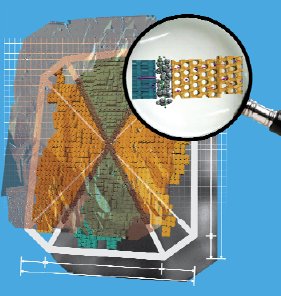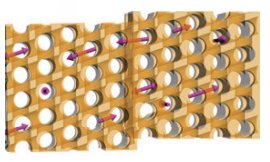Porous solid catalysts are a mainstay of the modern chemical industry, allowing reactions that would otherwise take an age to progress to be run much, much faster. One group of such catalysts are the zeolites and particularly important among them is one known as ZSM-5, an aluminosilicate material with an MFI structure. However, despite its attractions, ZSM-5 can behave badly because its chemical building blocks do not join together perfectly. This leads to chemical starting materials on which the catalyst is to act often becoming stuck before they can get into the reactive pores and be converted into product. Now, Dutch scientist Marianne Kox has discovered the nature of the miniscule deviations that can make ZSM-5 such a troublemaker.

Catalysts are essential to the production of a vast array of pharmaceutical drugs, agrochemicals, fuels and countless other chemical products that are made from simple starting materials. Kox and colleague Lukasz Karwacki, together with researchers at the Max Planck Institute for Coal Research in Mülheim an der Ruhr, Germany, ExxonMobil Chemical Europe Inc, Machelen, Belgium, the Centre for Nanoporous Materials, at the University of Manchester, UK, UOP LLC, a Honeywell Company, in Des Plaines, Illinois, USA, and Nicholas Copernicus University, Torun, Poland, have used a raft of spectroscopic techniques, on the micro scale to analyse the structure of zeolite ZSM-5 and have obtained spatial and time-resolved data on the three-dimensional interior of these porous materials. The data reveal the deviations from one porous unit to the next that can lead to reduced efficiency, catalytic poisoning, and unwanted chemical by-products.

Kox is working as part of the Vici project run by Bert Weckhuysen, Professor of Inorganic Chemistry and Catalysis at Utrecht University in The Netherlands. Details of the research were published in Nature Materials. The team developed a new approach that correlates confocal fluorescence microscopy with focused ion beam–electron back-scatter diffraction, transmission electron microscopy lamelling and diffraction, atomic force microscopy and X-ray photoelectron spectroscopy to study a wide range of coffin-shaped zeolite crystals of differing shapes, sizes, structures, and chemical compositions.
The powerful combination of techniques demonstrates “a unified view on the morphology-dependent MFI-type [zeolite] intergrowth structures and provides evidence for the presence and nature of internal and outer-surface barriers for molecular diffusion,” the team say. “It has been found that internal-surface barriers originate not only from a 90° mismatch in structure and pore alignment but also from small angle differences of 0.5 to 2 degrees for particular crystal morphologies. Furthermore, outer-surface barriers seem to be composed of a silicalite outer crust with a thickness varying from 10 to 200 nanometres.”
LINKS
Nature Mater, 2009, 8, 959-965
http://dx.doi.org/10.1038/nmat2530